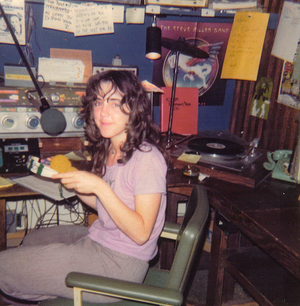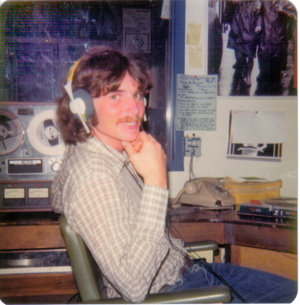Electronic media pioneers
Innovations by UC Santa Cruz students became facets of 1980s pop culture.
Once, while she was a programmer at KZSC, Denise Gallant was at a party, eavesdropping on a group of people who couldn’t agree on whether what she did on the radio was art.

She called her show Oblique Strategies after Brian Eno’s exercises for breaking creative blocks. Friday nights at 10, Gallant (Kresge ‘76, individual major) would read poetry through a reverb effect or overlay progressive rock and classical music.
“People would call up and say, ‘What IS that?’ ‘What are you doing?’” Gallant says.
At the party, a friend appeared to be about to reveal that Gallant was the DJ the group was debating.
“I was going, ‘Shh, shh don’t let them know I’m here,’” Gallant says.
KZSC was one locus of Gallant’s exploration with media and technology. Another was Kresge Town Hall, where she was Town Hall manager.
“One of my favorite things was to be in the Town Hall late at night and just envision what could go on there,” Gallant says. “It was my playpen, is what I called it.”
She hosted student performances that, like her radio show, combined seemingly discordant art forms: video, dance, music. The performances included work from the Electronic Music Studio, where Gallant and Rob Schafer (Kresge ‘76, individual major) were part of a circle of students pairing musical creations with other types of performance.
Building synopsis
In the Electronic Music Studio, Schafer and Gallant experimented with feeding video signals through audio synthesizer circuits. When they discovered interesting effects, they included them in performances.
This work continued after they completed their studies. They built a machine that could invert hue and brightness and convert black and white into rainbows. They could also convert sound waves into abstract shapes. Gallant called the device “Synopsis.”
Her first job after UC Santa Cruz was editing video for NBC in Los Angeles. She was perhaps the first woman in that job and regularly dealt with coworkers who assumed she couldn’t do the work or would ask her on dates. More than 40 years later, she still edits video and speculates she’s done it longer than any other woman in the industry.
New Age music’s signature videos
She continued improving the Synopsis, producing video effects for concerts in the Bay Area, Los Angeles, and Santa Cruz.
In the early 1980s she founded a company to produce music videos. By overlaying multiple videos and creating bizarre manipulations of color and contrast, she produced hundreds of abstract and surreal videos for Devo, the Grateful Dead, and Tangerine Dream, among others. Her effects were particularly popular for New Age bands.
Gallant also used the synthesizer to create the hallucinatory images of near-death experiences for the film Brainstorm.
You had me at “PFM”
When she had her show at KZSC, her future husband tried to sign up to take her time slot.

Kevin Monahan (Kresge) had come to UC Santa Cruz with a hunger to work with audio synthesizers. He joined the Electronic Music Studio, and when he became interested in starting a radio show, he asked about a Friday evening slot that appeared empty.
The station manager walked down the hall to the Electronic Music Studio, where Gallant was at work and told her.
“I don’t get mad very often,” Gallant says, “I just remember storming out of that room and going over to the radio station. I came over and was like, ‘Who’s this person? Who’s this person who wants to take my show?’”
She kept her slot, and eventually Monahan got his own show immediately following Gallant’s. He called it Obscure Reality and played electronic and progressive rock. Soon Schafer noticed Monahan was focusing on a single member of the audience.
“He’d say something like, ‘He’s playing that for you.’ And I’d say, ‘No, he’s not.’ And then Kevin would say my name, and I’d go, ‘Oh, this is embarrassing.’”
After a few months, Monahan’s collection, including the likes of Le Orme, Nectar, and Premiata Forneria Marconi began to truly draw Gallant’s interest.
“Kevin brought in these European imports that were totally rare and unique. I would walk over and say, ‘What’s that?’” she says. “It was the music that got to me.”
Making frogs into rock stars
Like Gallant, Monahan used his time at UC Santa Cruz to explore the potentials of technology. He built audio synthesizers and created experimental audio performances for Kresge Town Hall. His senior project included a recording of some Santa Cruz–area frogs.
Before Monahan completed his degree, the audio synthesizer company E-MU Systems moved to Santa Cruz and hired him. E-MU began building the “Emulator,” a keyboard that could play “samples” of sounds stored on computer discs.
Part of Monahan’s job was to create the “libraries” of sounds, and one of the sounds the Emulator shipped with was the frog recording.
In the keyboard-happy 1980s, pop bands made wide use of the Emulator. You can see it at work in the Jonathan Demme video for the New Order song “Perfect Kiss.” Just before the six-minute mark, keyboardist Stephen Morris plays a solo with the frogs.
Monahan’s work on the Emulator led to opportunities to tour with Peter Gabriel and more than a decade working for audio technology companies.
Gallant helped companies build video effect products. In 2000, she produced the visual effects for ABC’s coverage of the presidential election. She and Monahan now run a video production company from their home in Corralitos.
“It’s like we’re the people behind the scenes. We may not be famous, but we invent the tools for other people to use,” Gallant says. “That all comes out of UC Santa Cruz.”
Giving back
One night in the mid-1970s, when Gallant was Kresge Town Hall manager, two of Kresge’s video projectors were stolen from her car. “And I vowed at that point that someday I would pay Kresge back for losing those.”
Gallant’s and Monahan’s experiences at Kresge, hosting radio, and experimenting with media technology had profound effects on their lives, providing foundations for careers of invention.
They realized in 2017 that there is a way for Gallant to fulfill her vow to Kresge and to make a big difference for the radio station. They added Kresge and KZSC to their will.
“We’re so indebted to the school and the radio station,” Gallant says. “This planned gift is our way of giving back.”